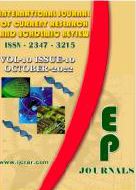Abstract Volume:10 Issue-10 Year-2022 Original Research Articles
 |
Online ISSN : 2347 - 3215 Issues : 12 per year Publisher : Excellent Publishers Email : editorijcret@gmail.com |
2Centre de Calcul, de modélisation et stimulation (CCMS), Mali
This study is based on the analysis of the water flowing of six hydrological stations in the Interior Niger Delta of the Niger river during the period 1980-2019, these stations are Ke-Macina, and Douna stations at theat entrance to the interior Delta, Sofara and Moptistations the center of Delta, and Akka and Dire stations the exit of the Inner Delta of the Niger River. This area is located in the semi-arid Sahelian zone. It is a vast flooding zone of approximately 40.000 km2 which stretches along a South-West and North-East axis (from Ke-Macina to Tombouctou) over more than 350 km between the parallels 17° and 13° North and the meridians 2°30 and 6°30 West. The highest value of the annual flood flow is observed at the Ke-Macina station with a water flow of 2173.99 m3/s and the lowest value of the flood recession flow is observed at the Douna station with 18.94 m3/s. From January to May, there is a decrease in the monthly water flow, in March with a value of 14.50 m3/s at the Sofara station. From the month of June, there is an increase in the monthly water flow to reach the flood flow during the months of September for the stations hydrological of Ke-Macina, Douna and Sofara and the month of October for Mopti station and November for Akka and Dire stations. The highest monthly water flow is observed at the Ke-Macina hydrological station with a value of 3137.74 m3/s. On all the six hydrological stations, the following observations are made: the period 1982-1993 constitutes the dry period and the period 1994-2019 is the wet period, except for a few years.
How to cite this article:
Mody Sow, Cheick Diarra and Namory Doumbia. 2022. Analysis of Water Flows in the Interior Niger Delta of the Niger River during the Period 1980-2019 in Mali.Int.J.Curr.Res.Aca.Rev. 10(10): 17-26doi: https://doi.org/10.20546/ijcrar.2022.1010.003



Quick Navigation
- Print Article
- Full Text PDF
- How to Cite this Article
- on Google
- on Google Scholor
- Citation Alert By Google Scholar
